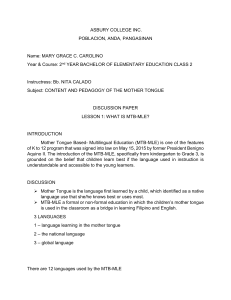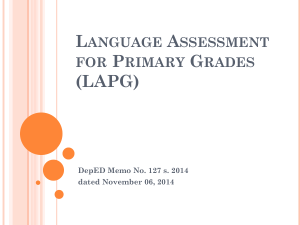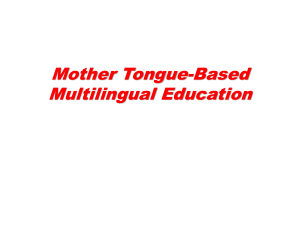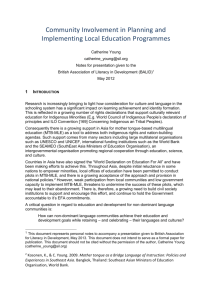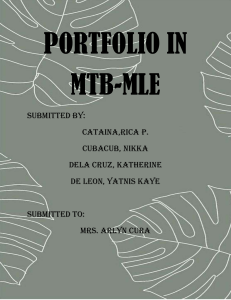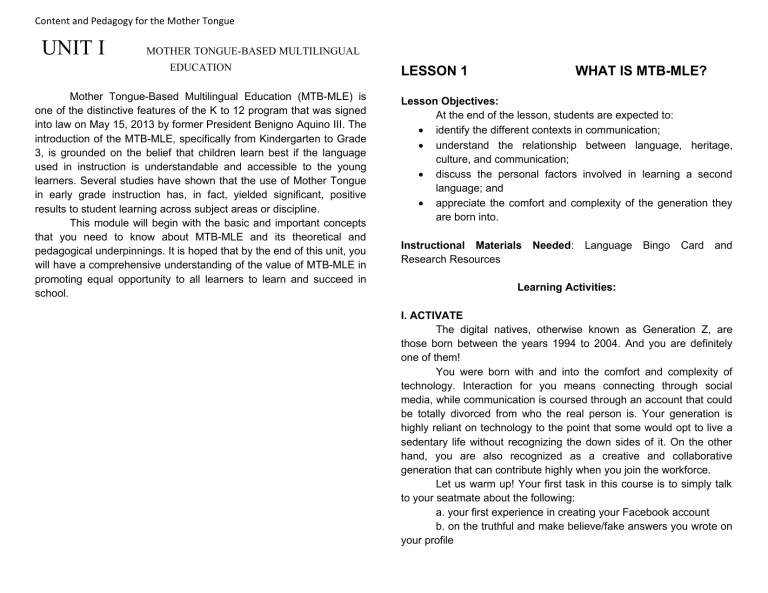
Content and Pedagogy for the Mother Tongue UNIT I MOTHER TONGUE-BASED MULTILINGUAL EDUCATION Mother Tongue-Based Multilingual Education (MTB-MLE) is one of the distinctive features of the K to 12 program that was signed into law on May 15, 2013 by former President Benigno Aquino III. The introduction of the MTB-MLE, specifically from Kindergarten to Grade 3, is grounded on the belief that children learn best if the language used in instruction is understandable and accessible to the young learners. Several studies have shown that the use of Mother Tongue in early grade instruction has, in fact, yielded significant, positive results to student learning across subject areas or discipline. This module will begin with the basic and important concepts that you need to know about MTB-MLE and its theoretical and pedagogical underpinnings. It is hoped that by the end of this unit, you will have a comprehensive understanding of the value of MTB-MLE in promoting equal opportunity to all learners to learn and succeed in school. LESSON 1 WHAT IS MTB-MLE? Lesson Objectives: At the end of the lesson, students are expected to: identify the different contexts in communication; understand the relationship between language, heritage, culture, and communication; discuss the personal factors involved in learning a second language; and appreciate the comfort and complexity of the generation they are born into. Instructional Materials Research Resources Needed: Language Bingo Card and Learning Activities: I. ACTIVATE The digital natives, otherwise known as Generation Z, are those born between the years 1994 to 2004. And you are definitely one of them! You were born with and into the comfort and complexity of technology. Interaction for you means connecting through social media, while communication is coursed through an account that could be totally divorced from who the real person is. Your generation is highly reliant on technology to the point that some would opt to live a sedentary life without recognizing the down sides of it. On the other hand, you are also recognized as a creative and collaborative generation that can contribute highly when you join the workforce. Let us warm up! Your first task in this course is to simply talk to your seatmate about the following: a. your first experience in creating your Facebook account b. on the truthful and make believe/fake answers you wrote on your profile Content and Pedagogy for the Mother Tongue c. an experience in helping someone to create a Facebook account d. compare social media accounts you maintain to communicate e. your engagement to social media as a means of communication on a daily basis Share your answers to the class through a video discussion. While our knowledge on Generation Z is still a work in progress, through the lens of education, we can safely say that the world they you are growing up in is more comprehensible. It is the day and age when the challenge of education is to prepare the forthcoming generation of learners to brave constant change and the challenges of the world. Education is not just simply a transfer of concepts and rote memorization, yet it is the readiness and capability to operate, compete and survive. More so, education is all about learners who think outside the box, employ higher order thinking skills, analyze, troubleshoot, make decisions, and solve problems. II. ANALYZE It is time to know your classmates in this course! Below is a Language Bingo Card and your goal is to cross out as many languages as possible. You will be given time to go around and ask your classmates the language/s that they speak or understand. Tagalo Language Ybanag Surigaonon Yakan g Bingo Kapampanga Iloko Ivatan Maranao Tausug n Pangasinens Maguindanaoa Hiligayno Cebuano Bikol e n n Chabacan Sambal Aklanon Kinaray-a Waray o What are the most common languages spoken/used by your classmates? Where do you think did they learn the language/languages? We thrive in a bilingual, or even in a multingual, world. This is the rationale why Mother Tongue, Filipino, and English follow a unified frame-work which allows easy transition from acquiring and learning one language to another. Republic Act 10533 "Enhanced Basic Education Act of 2013" has highlighted the reality and relevance of Mother Tongue-Based Multilingual Education (MTB-MLE). The implementation of the K to 12 Basic Education Program puts high premium on the learner's mother tongue and other languages used in the classroom. The Department of Education refers to Mother Tongue-Based Instruction through DO #74 s. 2009. The curriculum shall adhere to the principles and framework of Mother Tongue-Based Multilingual Education (MTB-MLE) which starts from where the learners are at and from what they already know, proceeding from the known to the unknown. Instructional materials and capable teachers to implement the MTB-MLE curriculum shall be available. In support of MTB-MLE, in 2013, DepEd issued DO #28, s. 2013-Additional Guidelines to DepEd Order No. 16, s. 2012 (Guidelines on the Implementation of the Mother Tongue-Based Multilingual Education MTB-MLE). Reality dictates that learners learn best when they are able to understand and express in the language they grew up speaking from childhood. Thus, they are able to build a strong scaffold in terms of comprehension, construction, and communication. Moreover, research stresses that children with a solid foundation in the language they grew up speaking or their mother tongue develop stronger literacy abilities in the school language. III. ABSTRACT In groups of three, you need to answer the questions listed below. You are encouraged to research and cite credible sources in answering each question. 1. What is acquisition? 2. How is language acquisition different from language learning? 3. How do children learn their first language? Content and Pedagogy for the Mother Tongue 4. What is second language acquisition? 5. Is language acquisition true for all children? Prepare to share your answers to the class. Language is the basis of all communication and the primary instrument of thought. Thinking, learning, and language are interrelated. Language is governed by rules and systems (language conventions) which are used to explore and communicate meaning. It defines culture which is essential in understanding oneself (personal identity), forming interpersonal relationships (socialization), extending experiences, reflecting on thought and action, and contributing to a better society. Language, therefore, is central to the peoples' intellectual, social, and emotional development and has an essential role in all key learning areas (English Curriculum Framework: Australia, 1998). Language is the foundation of all human relationships. All human relationships are established on the ability of people to communicate effectively with each other. Thoughts, values, and understandings are developed and expressed through language. This process allows students to understand better the world in which they live and contribute to the development of their personal perspectives of the global community. Therefore, proficiency in the language enables people to access, process, and assess information, to engage with the wider and more diverse communities, and to learn about the role of language in their own lives, and in their own and other cultures (Malone, 2006). Language acquisition (a natural process and involves "picking up" language in a nonconscious way through exposure to language, not by studying it) and language learning (is conscious, intentional, involves study and pays attention to grammar rules) is an active process from cradle to grave, and continues throughout life. It is continuous and recursive throughout students' lives. Students enhance their language abilities by using what they know in new and more complex contexts and with increasing sophistication (spiral progression). They reflect on and use prior knowledge to extend and enhance their language and understanding. By learning and incorporating new language structures into their repertoire and using them in a variety of contexts, students develop language fluency and proficiency. Positive learning experiences in language rich environments enable students to leave school with a desire to continue to extend their knowledge, skills, and interests (Cummins, 1991). Armed with the capability to read in their mother tongue, learners are able to cross over and read in other languages. Their knowledge and skills transfer across languages. This bridge then enables the learners to use both or all their languages for success in academics and most of all for lifelong learning. IV. APPLY Having the end in mind of instilling lifelong learning over and above academic excellence in Filipino learners, language learning in the mother tongue (L1), in Filipino (L2-the national language), in English (L3-the global language), and the possibility of a foreign language (L4), equips the learners to be more than prepared to develop the competencies in the different learning areas they will hurdle. For your final task in this lesson, form a group of five and discuss the following: (ONLINE ALL IF POSSIBLE) (IF YOU DON’T HAVE A GROUP DO IT WITH THE PEOPLE INSIDE THE HOUSEHOLD OR NEIGHBORHOOD) 1. Who is learning another language at the moment? 2. Who has tried to study another language out of passion or curiosity, or out of obligation to fulfill a duty? 3. If a second language was learned, how was the experience? 4. Is there someone in the group who can read books or newspapers and listens to radio/TV in another language apart from English and Tagalog? Each group. must prepare for a presentation of their key discussion points. Lesson Synthesis: Content and Pedagogy for the Mother Tongue Think of how you acquired and learned the languages that you have right now. How will you rate your level of proficiency for each of the language (10 points if you consider yourself highly proficient)? What language did you acquire first? Second? Or, did you acquire it simultaneously? Do you think it would make a difference if your L1 proficiency was well-established before you were exposed to your L2? LESSON 2 WHY MTB-MLE? Lesson Objectives: At the end of the lesson, students are expected to: discuss the reasons why learning a second language is important; discuss the personal factors involved in learning a second language; understand the Lingua Franca Education Project and its connection to Mother Tongue-Based Multilingual Education (MTB-MLE); and give a brief description of MTB-MLE. Instructional Materials Needed: Question cards Learning Activities: I. ACTIVATE and ANALYZE Question cards will be distributed randomly, decide whether you: Strongly Agree Agree with Reservations Somewhat undecided and most likely can be swayed to either side Strongly Disagree Prepare to share your answer and your justification to the class. 1. Language is an invention of groups of people in order to communicate effectively with each other in their local/particular community. Cite an example. 2. Language represents concepts that are particular to a specific culture. 3. Language represents the people, the culture, history, and heritage. 4. When we accept a language, we accept the culture. Content and Pedagogy for the Mother Tongue 5. Most language environments have words that are specialized and are used only in those environments. 6. Age does not really determine difference in language style. 7. The structure of language affects the way in which its respective speakers conceptualize their world or otherwise influences their cognitive processes. 8. New meanings are continually created as people change their ideas, feelings, and activities. 9. As people think, read, travel, make friends, and experience life, the associations and connections that words have for these people change. 10. Language determines how one thinks and processes information. II. ABSTRACT Read the text below and answer the questions that follow. Second language learning If you look in a dictionary to find the meaning of the word "acquisition," you will find it defined as something like "the process of learning skills or getting knowledge." So, what then is "language acquisition" and how is language acquisition different from "language learning"? Some theorists believe that there is a difference between learning and acquisition and that the difference is this: language learning is a conscious or intentional process which may involve studying the language, paying attention to grammar rules and possibly following a course of instruction. Language acquisition, on the other hand, is considered to be a natural process and involves "picking up" language in a nonconscious way through exposure to language, not by studying it. Children "acquire" their first language and get to know its rules through exposure and by being exposed to examples of the language and by using it. This is part of the theory of "first language acquisition." "Second language acquisition" is the process, and the study of the process, by which people learn a language that is not their native language. This is fairly new field of study and there are still many questions to answer about how languages are learnt. However, teachers and theorists believe that we do learn a second language by "acquiring" or "picking up" language, but there are some important considerations for second language learners. Second language learners acquire language through exposure to many different examples of the language, by reading it and by hearing it in their environment. We listen and read and develop an understanding of language over a period of time before we eventually use it ourselves. The period, when learners are taking in language, processing it and perhaps silently practicing it, is known as the "silent period" and is thought to be an important state in language acquisition. Once we use the language, it is important that there is an opportunity for interaction so we can use the language, to experiment, to make the language work in communication. The final consideration is the need for a focus on form. Second language. learners need to focus on the language, to analyze and identify it and practice it. Teachers and learners will also want to look at correcting mistakes so that learners can think about rules and exceptions to rules. 1. In your own words, differentiate language acquisition from language learning. ______________________________________________________________ ______________________________________________________________ ______________________________________________________________ _______________________________________ 2. What theory of language learning is discussed in the text? ______________________________________________________________ ______________________________________________________________ ______________________________________________________________ _______________________________________ 3. Does the theory avoid the teaching of grammar completely? Justify your answer. ______________________________________________________________ ______________________________________________________________ Content and Pedagogy for the Mother Tongue ______________________________________________________________ _______________________________________ In this lesson, it is important that you fully understand how we ended up adopting the MTB-MLE. It all began with the Lingua Franca Education Project (LFEP) where: the Department of Education, Culture and Sports embarked on a pilot study called Lingua Franca Education Project in SY 1999-2000 which was aimed to define and implement a national bridging program from the vernacular to Filipino, and later English to develop initial literacy for use in public schools. Through the bridging program, an alternative curriculum will be used in acquiring basic literacy and numeracy skills with the local lingua franca as the language of instruction. the pilot study involved two Grade 1 classes from each of the 16 regions. One was the experimental class and the other the control class. two Grade 1 teachers from each of the experimental schools, together with the principal, underwent training before the pilot study. One teacher handled the Grade 1 experimental class while the other taught the alternate class. The Lingua Franca used in the pilot study were as follows: Regions I, II, CAR- Ilocano Regions III, IV, V, VI, XII, ARMM, NCR - Tagalog Regions VII, VIII, IX, X, XI, CARAGA - Cebuano Since the Lingua Franca Education Project (LFEP) DECS Memorandum No. 144 s.1999, Mother Tongue-Based Multilingual Education Program is the most vital reform for the country's basic education and school system as a whole. The lessons from the findings of various international and national studies on language used in education undertaken by UNESCO are one in affirming the benefits and relevance of MTB-MLE which are in conformity with the recommendations given by the Basic Education Sector Reform Agenda (BESRA) to improve learning outcomes and promote Education for All (EFA). As research shows, (Dutcher, 1994: Tucker, 1998; Klaus, 2001: Thomas, 2002; Dekker and Young, 2007; Durnnian, 2007; UNESCO, 2007 b; Dekker, Duquiang, 2008; Noorlander & Van, 2008), quality education occurs most effectively when the mother tongue, the learner's home language, is used for initial learning the first language is the language of learning. It is by far the easiest way for children to interact with the world. And when the language of learning and the language of instruction do not match, learning difficulties are bound to follow (World Bank, 2006, page 4). III. APPLY MTB-MLE is a theoretically-based and well-planned educational program that provides a strong foundation for literacy using the learners developing cognitive skills and comprehension of academic content. Listed below are the "promises" of the MTB-MLE to its learners. Literacy Prior Knowledge Cognitive Development and Higher Order Thinking Skills (HOTS) Strong Bridge Scaffolding Teaching for Meaning and Accuracy Confidence Building and Proficiency Development for Two or More Languages along the Macro Skills of Communication You may have been learning about MTB-MLE and its value, but it is also important that early on, you are exposed to the problems and challenges that it has been facing these past years. With a partner, your final task for this lesson is to interview an elementary teacher who has taught or is teaching Mother Tongue as a learning area. The interview may be done face-to-face or even a messaging/chat interview. On a short bond paper, prepare a two-page interview essay on the following points: advantages of teaching Mother Tongue as a subject for both the learners and the teacher; Content and Pedagogy for the Mother Tongue challenges or problems encountered; solutions that were created so far to address the problems; and further recommendations to better achieve the goals of MTBMLE. CRITERIA FOR GRADING THE INTERVIEW ESSAY Content Sentence Fluency Organization Conventions 20 points The essay is clear, focused, and provides relevant evidence, examples, and details to support the central theme. 10 points Writing is easy to follow. 10 points The organization enhances the central idea of the essay. 5 points Observes correct grammar and mechanics Lesson Synthesis: For you, what do you foresee as challenges or difficulties that you will encounter when you teach Mother Tongue as a learning area? Prepare to share your insights to the class. _______________________________________________________ _______________________________________________________ _______________________________________________________ _______________________________________________________ _______________________________________________________ _______________________________________________________ _______________________________________________________ _______________________________________________________ _______________________________________________________ _______________________________________________________ _______________________________________________________ _______________________________________________________ _______________________________________________________ ______________________ Content and Pedagogy for the Mother Tongue LESSON 3 MLE? CONTENT OF THE MTB- Lesson Objectives: At the end of the lesson, students are expected to: understand the framework of the MTB-MLE; gain deeper insight on the MTB-MLE curriculum; draft a proposal on refinements/improvements of the curriculum; and suggest ways of integrating MTB-MLE issues into the curriculum. A framework, when used in any context, implies a means of organizing and managing content in systematic ways. With this, we can define a curriculum framework as the one responsible in regulating the content of the curriculum; it sets the parameters, directions, and standards for curriculum policy and practice. With your partner, try to make sense of the MTB-MLE Curriculum Frame work shown below. Discuss the questions that follow afterwards. Instructional Materials Needed: Mother Tongue Curriculum Guide Learning Activities: I. ACTIVATE As a class, discuss what "curriculum framework" means and its purpose. Create a simple graphic organizer in the box below that will encapsulate your understanding of a curriculum framework based on your discussion. Use your own words as much as possible. II. ANALYZE and ABSTRACT Form a group with four members. Your task this time is to understand the Department of Education's curriculum framework for Mother Tongue as a learning area. Before your task, it is crucial that we have a common knowledge of frameworks, specifically what a curriculum framework is. 1. What are the current and relevant issues in relation to our Philippine curriculum? _______________________________________________________ _______________________________________________________ _______________________________________________________ ____________________________________ 2. With the curriculum framework shown above, do you think these issues will be addressed? Content and Pedagogy for the Mother Tongue _______________________________________________________ _______________________________________________________ _______________________________________________________ ____________________________________ 3. What are the teaching and learning priorities of the framework that set the foundation of the framework? _______________________________________________________ _______________________________________________________ _______________________________________________________ ____________________________________ 4. How is content organized in the curriculum framework? _______________________________________________________ _______________________________________________________ _______________________________________________________ ____________________________________ Prepare for a class discussion. III. APPLY With a partner, your last task for this lesson is to prepare a two-page position paper that will discuss the following: 1. What needs to be improved (if any)? 2. How does the MTB-MLE curriculum support/complement (or contradict) first and second language acquisition theories? 3. If you will be given the chance to improve the framework, what changes will you incorporate? Try to re-create the MTB-MLE framework based on your suggestions. Please refer to the Curriculum Guide for Mother Tongue. CRITERIA FOR GRADING THE INTERVIEW ESSAY Content and Development Organization and Structure 30 points The paper takes a strong and well defined position with adequate support 10 points The structure of the paper is clear and easy to follow. Grammar and Mechanics 10 points Rules of grammar, usage, punctuation, and spelling are followed Lesson Synthesis: Make sure to share your significant insights from your position paper to the class. As a class, agree on common points that your class thinks should be improved in the Mother Tongue curriculum framework.
